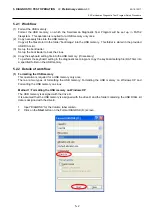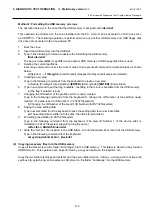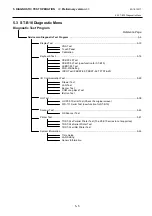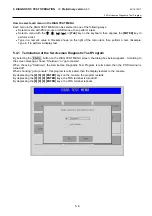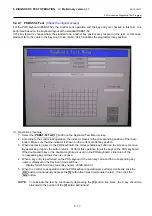
5. DIAGNOSTIC TEST OPERATION << Preliminary version >>
EO18-12017
5.2 Serviceman Diagnostic Test Program Setup Procedure
5- 4
(3) Boot
loader
setup
To boot the Linux, a boot loader should be set up into the USB memory.
The file “syslinux” is used as the boot loader.
(This file can be downloaded from
http://syslinux.zytor.com/iso.php
.)
Method 1: Setup on Windows XP
1.
Boot the command prompt.
2.
Change the directory to the drive E.
3. Type
in
syslinux.exe D:
, then depress the
[ENTER]
key to execute syslinux.
Example)
When you run in Windows XP, it is assumed that the USB memory is the drive D.
Also it is assumed that the folder containing the USB DIAG. kit data is the drive E.
1.
Boot the command prompt.
2.
Change the directory (
cd
) to
/syslinux/win32
in the drive E.
3. Execute
>
syslinux.exe -ma D:
.
Method 2: Setup on Linux
1.
Boot the POS terminal.
2. Type
in
cd syslinux/linux
.
3. Type
in
syslinux.exe D:
, then depress the
[ENTER]
key to execute syslinux.
Example)
When you run in Windows XP, it is assumed that the USB memory is the drive D.
Also it is assumed that the folder containing the USB DIAG. kit data is the drive E.
1.
Boot the command prompt.
2.
Change the directory (
cd
) to
syslinux/win32
in the drive E.
3. Execute
syslinux /dev/sda1
.
(4) Copying the keyboard setting file into the USB memory (if necessary)
In the Serviceman Diagnostic Test Program, the key allocation setting of the POS keyboard connected to
the POS terminal can be programmed.
To perform the POS keyboard setting in the diagnostic test program, copy DAT file storing the key allocation
setting into the “setkbd” folder on the USB memory. (This DAT file should be prepared separately.)
Now the Serviceman Diagnostic Test Program Setup for the USB memory is successfully completed.













